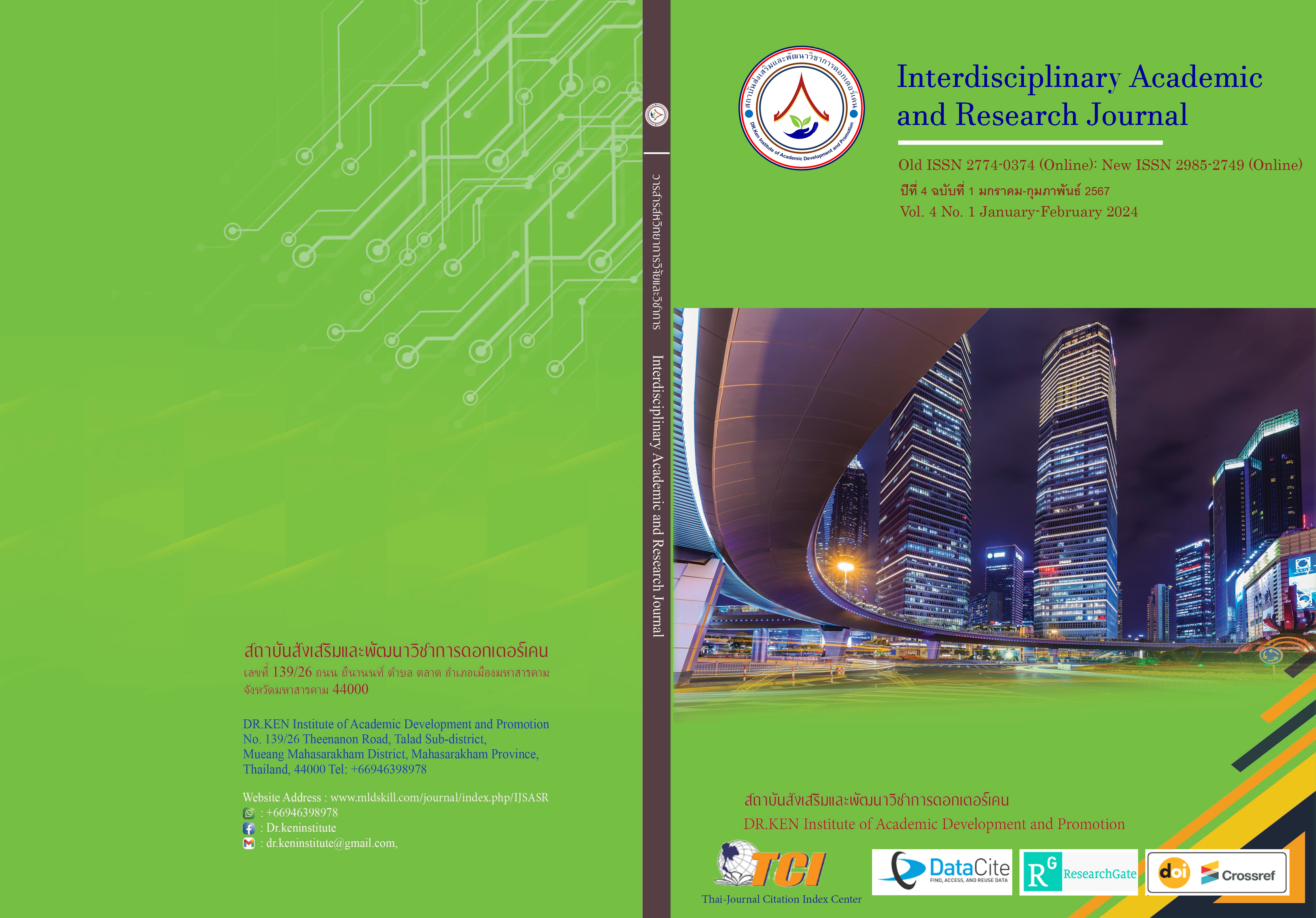Effects of Complex Training Combined with the Practice of Imagery on Muscle Strength, Flexibility, and Serving Accuracy of Double Regu Sepaktakraw, Thailand National Sport University
DOI:
https://doi.org/10.60027/iarj.2024.272701Keywords:
Complex Training; , Imagery Practice;, Muscle Strength; , Flexibility; , Serving AccuracyAbstract
Background and Aims: Developing the ability of a Sepak Takraw athlete to reach their full potential as a server requires developing correct leg swing patterns and body movement. The ability to enhance leg swing in Sepaktakraw is flexibility. This is the main part of raising the feet to the highest level and helps support the movement of the body, increasing the degree of movement and increasing the perfection of movement skills. Thus, the purposes of this study were to examine and make a comparison between the effects of complex training combined with the practice of imagery on muscle strength, flexibility, and serving accuracy of double regu Sepaktakraw, Thailand National Sports University.
Methodology: The samples were 40 Sepaktakraw players of Thailand National Sports University, Sisaket Campus, in the age range of 19–25 years old and parted into 2 groups; the 1st group was in the experimental group and performed the complex training together with the imagery practice; the 2nd group were in the control group and tried out with only the complex training. The instruments used to examine them were the complex training program, the imagery with the Sepaktakrwa serving program, and the imagery practice questionnaire. The tools used to collect data were the leg dynamometer test for muscle strength, the sit and reach test for flexibility, and the Sepaktakrwa serving accuracy test. Both the control and experimental groups spent 8 weeks of training, 3 days each, on Monday, Wednesday, and Friday. After the 8 weeks of training, the data was analyzed using means, standard deviation, a dependent t-test within the group before and after the 8-week duration of training, and a dependent t-test between groups after the 8th week.
Results: After the 8th week of training, the experimental and control groups had higher leg muscle strength, flexibility, and accuracy in serving Sepaktakrwa balls than before training, at a statistical significance of .05. The results of comparing leg muscle strength, flexibility, and accuracy in serving Sepaktakrwa balls between groups found that after the 8th week of training, the experimental group had higher muscle strength, flexibility, and accuracy in serving Sepaktakrwa balls. The control group has statistical significance at the .05 level.
Conclusions: The results of the study showed that after the 8th week of training, the experimental group showed higher improvements in leg muscle strength, flexibility, and precision in Sepaktakrwa serves compared to the control group. It has a significant statistical value at the .05 level for every measurement item that was made.
References
จตุรงค์ เหมรา. (2561). หลักการและการปฏิบัติ: การทดสอบสมรรถภาพทางกาย. สำนักพิมพ์แห่งจุฬาลงกรณ์มหาวิทยาลัย.
เจริญ กระบวนรัตน์. (2552). การยืดเหยียดกล้ามเนื้อStretching Exercise. มหาวิทยาลัยเกษตรศาสตร์.
โชติกา บุญทอง. (2557). ผลการฝึกพลัยโอเมตริกและการฝึกด้วยน้ำหนักที่มีต่อพลังกล้ามเนื้อขาและความแข็งแรงของกล้ามเนื้อขาในการกระโดดสกัดกั้นของนักกีฬาเซปักตะกร้อหญิง. ปริญญานิพนธ์วิทยาศาตรมหาบัณฑิ: มหาวิทยาลัยมหาสารคาม.
ธีระศักดิ์ อาภาวัฒนาสกุล. (2552). หลักวิทยาศาสตรในการฝึกกีฬา. กรุงเทพฯ: สำนักพิมพ์จุฬาลงกรณ์มหาวิทยาลัย.
ภัสสร ธูปบุตร. (2562). ผลการฝึกแบบผสมผสานและการฝึกแบบควบคู่ที่มีต่อพลังกล้ามเนื้อขาและ ความคล่องแคล่วว่องไวของนักกีฬาวอลเลย์บอลหญิง. ปริญญานิพนธ์การศึกษามหาบัณฑิต: มหาวิทยาลัยศรีนครินทรวิโรฒ.
รณภพ ชาวปลายนา. (2561). ผลของการฝึกเชิงซ้อนแบบเอกเซนตริกที่มีต่อสมรรถภาพของกล้ามเนื้อขาในนักกีฬาฟุตบอล. กรุงเทพฯ: จุฬาลงกรณ์มหาวิทยาลัย.
วีระพงษ์ แดนดี. (2564). ผลการฝึกการรับรู้ของประสาทกล้ามเนื้อกับความเร็ว พลัง และความคล่องแคล่วว่องไวที่มีต่อความสามารถในการรับเสิร์ฟในนักกีฬาเซปักตะกร้อ. (รายงานการวิจัย). มหาวิทยาลัยการกีฬาแห่งชาติ วิทยาเขตศรีสะเกษ.
ศราวุฒิ โภคา และสุธนะ ติงศภัทิย์. (2557). ผลของโปรแกรมการฝึกทักษะการเสิร์ฟเซปักตะกร้อร่วมกับการฝึกการทรงตัว ความอ่อนตัว และความแข็งแรงของกล้ามเนื้อที่มีต่อทักษะการเสิร์ฟเซปักตะกร้อของนักเรียนมัธยมศึกษาตอนต้น. An Online Journal of Education, 9(2), 117–131. Retrieved from https://so01.tci-thaijo.org/index.php/OJED/article/view/20316
ศศิมา พกุลานนท์ และนิภาวรรณ กันทา. (2558). ผลการฝึกทักษะการเสิร์ฟควบคู่กับการฝึกจินตภาพ พร้อมการฟังเพลง ต่อความแม่นยำของการเสิร์ฟในนักกีฬาเซปักตะกร้อ มหาวิทยาลัย แม่ฟ้าหลวง. วารสารวิทยาศาสตร์และเทคโนโลยีการกีฬา. 15(1), 223-230
เศกสิทธิ์ ถาวรศิริ. (2563). ผลของการฝึกเสิร์ฟควบคู่กับการฝึกจินตภาพที่มีผลต่อความแม่นยำในการเสิร์ฟของนักกีฬาเซปักตะกร้อชาย. วิทยานิพนธ์การศึกษามหาบัณฑิต: มหาวิทยาลัยนเรศวร
สมบัติ กาญจนกิจ และสมหญิง จันทรุไทย. (2542).จิตวิทยาการกีฬา : แนวคิด ทฤษฎีสู่การปฏิบัติ. กรุงเทพฯ : สำนักพิมพ์แห่งจุฬาลงกรณ์มหาวิทยาลัย
สลักจิตร คณะฤทธิ์ และคณะ. (2564). ผลการฝึกเสริมความอ่อนตัวควบคู่กับการจินตภาพที่มีต่อความแม่นยำในการเสิร์ฟของนักกีฬาเซปักตะกร้อชาย มหาวิทยาลัยราชภัฏเพชรบูรณ์. วารสารราชภัฏเพชรบูรณ์, 23(1), 69-75.
สันติ วัฒน์พันทา. (2548). เซปักตะกร้อ. สกลนคร : ภาควิชาพลศึกษา คณะครุศาสตร์สถาบันราชภัฏสกลนคร.
สุพจน์ปราณี. (2551). เซปักตะกร้อคู่มือกลยุทธ์การฝึกทักษะกีฬา. กรุงเทพฯ : โอเดียนสโตร์,.
สุพิตร สมาหิโต. (2546).จิตวิทยาการกีฬาสำหรับผู้ฝึกสอนและนักกีฬา. สารวิทยาศาสตร์การกีฬา. 4(35),14-17.
เสาวลักษณ์ ศิริปัญญา. (2550). ผลของการฝึกเชิงซ้อนแบบผสมผสานการฝึกด้วยน้ำหนักกับการเคลื่อนที่ในลักษณะแรงระเบิดที่มีต่อสมรรถภาพของกล้ามเนื้อในนักกีฬาเซปักตะกร้อหญิงทีมชาติไทย. วิทยานิพนธ์วิทยาศาสตรมหาบัณฑิต: จุฬาลงกรณ์มหาวิทยาลัย.
Bompa, T., & Buzzichelli, C. (2015). Periodization Training for Sports. Washington, United States.
Cumming, J., & Ste-Marie, D.M. (2001). The Cognitive and Motivational Effects of Imagery Training: A Matter of Perspective. The Sport Psychologist, 15(3), 276–288. https://doi.org/10.1123/tsp.15.3.276
Feltz, D.L., & Landers, D.M. (1983). The Effects of Mental Practice on Motor Skill Learning and Performance: A Meta-Analysis. Journal of Sport Psychology, 5(1), 25–57. https://doi.org/10.1123/jsp.5.1.25
Kraemer, W.J., & Ratamess, N.A. (2004). Fundamentals of resistance training: Progression and exercise prescription. Medicine and Science in Sports and Exercise, 36(4), 674–688.
O’Shea, J.P. (1976). Scientific Principles and Methods of Strength Fitness. 2nd edition. Reading: Addison. Wesley.
Schempp, P.G., & McCullick, B.A. (2003). Importance of Perceptual-Motor Skills in Sport and Physical Education. Perceptual and Motor Skills, 96(1), 3–4. https://doi.org/10.2466/pms.2003.96.1.3
Weinberg, R., & Gould, D. (2015). Foundations of sport and exercise psychology. Human Kinetics.
Downloads
Published
How to Cite
Issue
Section
License
Copyright (c) 2024 Sanit Srichalee

This work is licensed under a Creative Commons Attribution-NonCommercial-NoDerivatives 4.0 International License.
Copyright on any article in the Interdisciplinary Academic and Research Journal is retained by the author(s) under the under the Creative Commons Attribution-NonCommercial-NoDerivatives 4.0 International License. Permission to use text, content, images, etc. of publication. Any user to read, download, copy, distribute, print, search, or link to the full texts of articles, crawl them for indexing, pass them as data to software, or use them for any other lawful purpose. But do not use it for commercial use or with the intent to benefit any business.
















.png)


